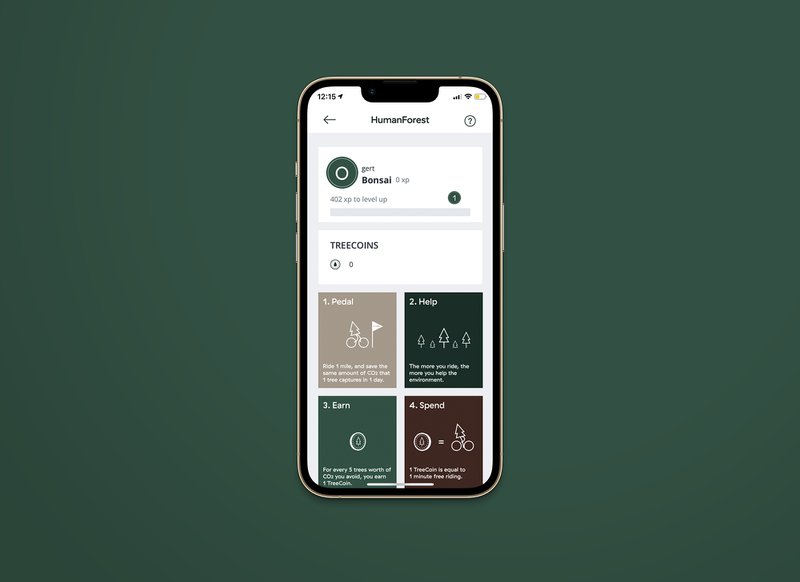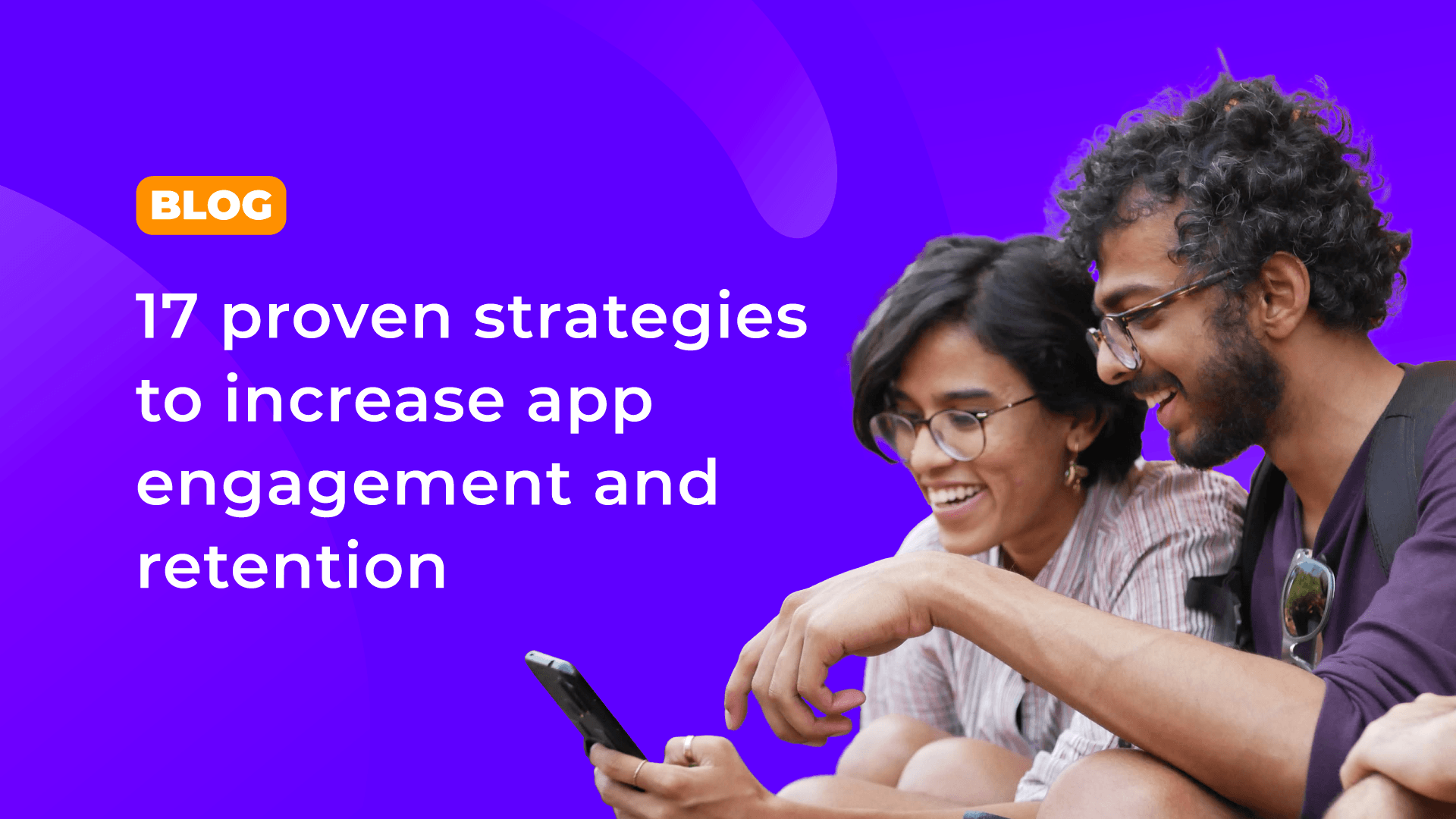

How mobility app HumanForest is using gamification to make the world a better place
How mobility app HumanForest is using gamification to make the world a better place

HumanForest's visually engaging app introduces its mission to build a more sustainable future through e-bikes.
By far, people see climate change as the most serious problem facing the world today. This creates a huge opportunity for mobility apps to make an impact on green and sustainable behavior. One such app is the e-bike sharing app HumanForest, which is on a mission to make the London metropolis more green. Their new and exciting app is full of gamification examples that improve the user experience and provide the necessary motivation towards sustainable urban mobility.
We spoke to Co-founder and Head of Marketing, Michael Stewart, about some of the gamification examples they use, and how it motivates Londoners to go green! He told us all about how gamification differs from a “copycat” loyalty program and why he decided to work with StriveCloud.
Let’s dive in!
- Who is HumanForest?
- 3 trends changing how we travel (and how HumanForest is ready)
- The gamification examples that motivate greener behaviors on HumanForest app
- An in-game currency that matters
- Leaderboards that rank how many trees users have saved
- Levels encourage long-term engagement
- Recap
Who is HumanForest?
HumanForest is a shared mobility provider from London, that has the mission of making micro-mobility more affordable & sustainable. They discovered that motivating people to use sustainable transportation, could help them recover CO2 emissions worth a forest.
"We started in London, because here we saw the biggest opportunity. Micro-mobility was expensive and there weren’t many other operators."
Compared to other mobility services HumanForest wants to make theirs easily accessible. That’s why every user receives 10 minutes of free riding per day. HumanForest shows an advertisement at the beginning & end of every ride. They make sure it’s always related to a green cause, climate change, or sustainability. It allows brands to promote sustainable behavior on a relevant & credible channel.
3 trends changing how we travel (and how HumanForest is ready)
Mobility apps are becoming an important part of tackling climate change. With sustainability in mind, people are changing how they get from A to B. Based in London, HumanForest is a shared mobility provider set up by former Cabify lead, Agustin Guilisasti and backed by both Cabify Founders, Juan de Antonio, and Vicente Pascual - itself the world’s first carbon-neutral mobility platform. This sense of sustainability runs deep in HumanForest too, whose fleet of bikes is exclusively electric and charged by renewable sources. Currently, the company is valued at an impressive £32 million (€37.7 million).
Figuring out user motivation will fuel your app growth. Kickstart your process with an expert-led workshop & go home with a roadmap tailored to your app goals!
In 2017, e-bike apps served over 500 million people. In 2025, that number will be closer to 900 million! HumanForest is planning to grow along with the explosive market expansion.
These 3 trends reveal what’s behind the increase:
#1 Cities want sustainable solutions
Local governments are doing their part to fulfill the climate promises signed at the Paris accords. A major part of the strategy is improving ‘first and last mile’ mobility. Essentially, most people don’t live within a convenient distance of their nearest train or bus stop, and this portion of the journey is where the car still holds sway.
"We’re thinking about big capitals because of the high need for micro-mobility & environmental awareness. In the future, we’re looking to expand to bigger capitals within Europe."
To be sure, city authorities see the value in e-bike operators like HumanForest. While London is a difficult patchwork of 32 councils that often don’t agree, HumanForest founder Agustin Guilisasti boasts that they’ve not lost a single tendering application.
#2 Less driving, more cycling
According to research by Kantar, the car is still responsible for more than half of all journeys in large cities worldwide. The future is greener, however. In 2030, the percentage of automobile trips will decline to 46%. Among that number, shared rentals and electric cars will take over. When it comes to alternative modes of transport, cycling will see the biggest boost of all with an 18% increase.
#3 Customer-centric design
To make the best journey choices, travelers need to be empowered with the right tools. Research from the journey planner app Moovit shows that consumers' expectations are changing to want a more customer-centric design. Users want more options, more control, and more immediate service.
For mobility apps, this can mean showing users the closest bike, when the bus is arriving, or if the train will be crowded. These features will make shifting to sustainable transport even more convenient and streamlined.

These fully electric bikes are the foundation of HumanForest's sustainable mobility solution, powered entirely by renewable energy.
3 gamification examples that motivate greener behaviors on HumanForest App
It isn’t easy to encourage people to hop on a bike over a personal car - or over the bike of your competitor, for that matter. But gamification can help! While a lot of competition in shared mobility is based on price differentiation, there are other ways to get people on your platform that don’t include razor-thin margins.
Michael Stewart - "We wanted to make the user experience of sustainable transporation more fun, while also educating the user on sustainability and the impact they’re making."
A gamified app experience, it’s a starting point for in-app differentiation. Features like leaderboards and points, improve user engagement and motivate active participation in the long run. In short, gamification will:
- Make the user experience fun and rewarding, which research shows leads to customer loyalty.
- Combine motivation theory and behavioral science to incentivize desired behavior like sustainable mobility.
- Satisfy basic psychological needs like knowledge, growth, and status.
What is gamification & how does it work? Learn all the basics right here!
Seeking these benefits, HumanForest joined forces with StriveCloud and together designed, co-created, and launched a loyalty program that rewards users for moving sustainably around London.
Michael Stewart - "We looked at many loyalty systems but we wanted to do more than random loyalty rewards. With StriveCloud we could infuse fun in the experience, articulate our mission & integrate it within the app experience. Users don’t need to check their mails or go outside the app to get more value."
Here are some awesome gamification examples from HumanForest:
An in-game currency that matters
The more people ride HumanForest, the more ‘TreeCoins’ they earn. But the TreeCoins are no made-up coins, they’re actually the number of trees each user has saved by taking an e-bike! For every mile by bike users represent 1 tree in saved CO2. Every 5 miles or trees gets the users 1 TreeCoin, which gives them 1 minute of free riding or discounts with environmentally conscious retailers.
Michael Stewart - "StriveCloud really helped us fulfill our brand message. The TreeCoins explains our mission perfectly. 1 mile = 1 tree, 5 miles = 5 trees & 5 trees = 1 coin. The progress visualization mechanic prompts users to keep using HumanForest & rewards sustainable behavior with free minutes!"
This visualization makes the currency feel much more tangible - and in turn much more valuable. Users can literally see their positive impact on our planet! A great benefit of that is that it will inspire users to share how many trees they’ve saved, giving users something to brag about.

This screenshot from the app shows how tangible rewards like 'TreeCoins' directly link user actions to a positive environmental impact, making progress feel meaningful.
Leaderboards that rank how many trees users have saved
People like to see themselves grow and they like to be rewarded. But they also need to fulfill a sense of social relatedness and a leaderboard can do just that. By ranking the trees that each user saves against each other, users feel will more motivated. The challenge feels real when others are joining in and this extra rush is super motivating.
Level up your profile, level down your carbon footprint!
The user reward isn’t just made by TreeCoins. They also have the chance to level up their profiles based on the number of rides taken. Users can collect experience points and work up from their original ‘bonsai’ avatar. This works as a great status symbol that rewards those who put in an extra effort.
These gamification features serve to create for HumanForest a platform that is a must-have in today’s competitive app market - a platform that is fun, empowering, and above all, customer-centric.
Michael Stewart - "I really like how easy-to-use StriveCloud is. I don’t need to interrupt any developers or use any code, there’s no lengthy deployment process & changes are updated instantly."
More than that, if you can be those things while making a positive impact on something so important like climate change, then your app will stand an even greater chance of success.
Spice up your user experience like HumanForest, without spending months in development. Find out more →
Recap
By far, people see climate change as the most serious problem facing the world today and mobility apps like the new e-bike service provider, HumanForest, are tackling the challenge.
Based in London, HumanForest is a shared mobility provider - itself the world’s first carbon-neutral mobility platform. HumanForest is also sustainable; their fleet of bikes is exclusively electric and charged by renewable sources. Currently, the company is valued at €37.7 million.
It’s clear that e-bikes are the future - in 2017, e-bike apps served over 500 million people. In 2025, that number will be closer to 900 million!
3 trends changing how we travel (and how HumanForest is ready)
#1 Cities want sustainable solutions to the first and last mile challenge
A major part of tackling climate change in urban mobility is solving the ‘first and last mile’ challenge. Essentially, most people don’t live within a convenient distance of their nearest train or bus stop, and this portion of the journey is where the car still holds sway.
City authorities see the value in e-bike operators like HumanForest to fix this. While London is a difficult patchwork of 32 councils that often don’t agree, HumanForest founder Agustin Guilisasti boasts that they’ve not lost a single tendering application.
#2 Less driving, more cycling
According to research by Kantar, the car is still responsible for more than half of all journeys in large cities worldwide. The future is greener, however. Cars will decline to 46% and cycling will see the biggest boost of all transport modes with an 18% increase.
#3 Customer-centric design
To make the best journey choices, travelers need to be empowered with the right tools. Research from the journey planner app Moovit shows that people crave customer-centric design. Users want more options, more control, and immediate services. These features will make shifting to sustainable transport convenient and streamlined.
The gamification examples that encourage green behaviors
Gamification can help encourage people to hop on a bike over a personal car - or over the bike of your competitor. In short, gamification will:
- Incentivize desired behavior like sustainable mobility.
- Make the user experience fun, which research shows leads to customer loyalty.
- Satisfy basic psychological needs like knowledge, growth, and status.
Seeking these benefits, HumanForest joined forces with StriveCloud and together have designed, co-created, and launched a loyalty program that rewards users for moving sustainably around London. This is how:
An in-game currency that matters
The more customers ride HumanForest, the more ‘TreeCoins’ they earn. These are actually the number of trees each user has saved by taking an e-bike! This visualization makes the currency feel much more tangible - and in turn a more valuable achievement.
Leaderboards that rank how many trees users have saved
People like to see themselves grow and they like to be rewarded. But they also need to fulfill a sense of social relatedness and a leaderboard can do just that. By ranking the trees that each user saves against each other, users feel will more motivated. The challenge feels real when others are joining in and this extra rush is super motivating.
Level up your profile, level down your carbon footprint!
Users can collect experience points and work up from their original ‘bonsai’ avatar. This works as a great status symbol that rewards those who put in the extra effort.
On the whole, these gamification features serve to create for HumanForest a platform that is a must-have in today’s competitive app market - a platform that is engaging, fun, empowering, and above all, making a positive impact on the environment!
Drive the behaviors you want to see! Get an expert-led gamification workshop & learn how to design for customer motivation!
Related Posts

17 proven strategies to increase app engagement and retention
User engagement and retention go hand in hand. Research shows that 90% of new users who engage have a higher 30 Day retention. 77% of those who don’t churn after 1 month. So how can you boost engagement, and retention in turn? Here are 17 actionable strategies to boost your app!

How to improve feature discovery for SaaS apps (and why it’s necessary)
In reality, 12% of a product’s features attract the majority of user engagement. That leaves plenty of room for improvement. Feature discovery is a great way to spread awareness & educate users on your product. As the perceived value of your product rises, so do retention rates!

